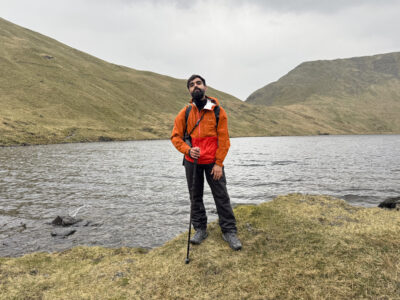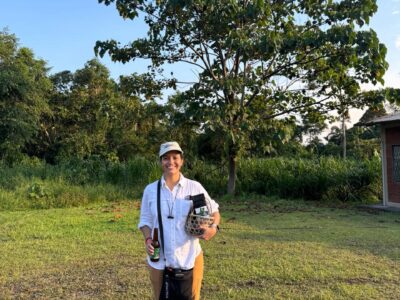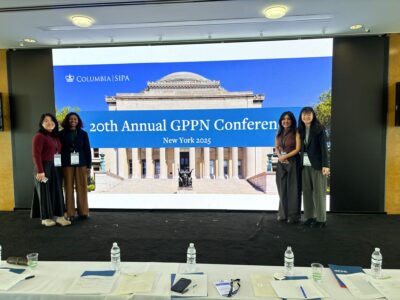
For Jessica Cunningham, the MPA in Environmental Science and Policy program offers the ideal tools for a successful career in environmental policy. By combining an innovative science curriculum with professional experience in project management, Jessica is preparing to launch a career in urban planning policy following graduation.
1. What drew you to the Master of Public Administration in Environmental Science and Policy program (MPA-ESP)? When I first started looking into environmental science programs I was slightly overwhelmed with all of the options available. There are programs for everything from forestry management and agriculture to energy and urban planning, which made it difficult to narrow down the choices. Then I found the MPA-ESP program and knew it was exactly what I wanted. One of the biggest selling points of this program for me is that it’s a one year, accelerated degree. This was very appealing as I had already been in the working world and wanted to return as quickly as possible. This policy program also has the most science curriculum in the country, has unparalleled support from the Earth Institute and Columbia in general, and is taught by experts in their fields. In addition, this program covers a lot of the above-mentioned subjects and gives us a wide-ranging understanding of all the different aspects in environmental studies.
2. What were you doing before you started the program? Prior to enrolling in the program I had two jobs as a project manager; one was with a nonprofit and the other was with an executive search firm. When I graduated from college I didn’t know exactly what I wanted to do, but I knew I wanted to work and get experience. This was the best approach for me because I acquired invaluable skills and it helped focus my interests. I enrolled in two graduate level environmental courses to get a better understanding of the subject and loved it. From there I researched programs and found this one.
3. What area of environmental policy and management are you most interested in? I am very interested in urban planning with a particular focus on energy and resource infrastructure. We are currently wrapping up our second semester in The Workshop in Applied Earth Systems Management where I am part of the Water Infrastructure Resiliency and Sustainability Act of 2013 group. The workshop has taught me a lot about infrastructure and urban planning policy, which I would like to continue to do in my career.
4. What skills and tools do you hope to acquire through the program? The most important skill I have learned is looking at the entire life cycle of a project or policy and how it affects and is affected by various externalities. Policy work is so intermingled with many different facets of society that you have to understand what influence your work will have.
5. What is your favorite class in the MPA-ESP program so far, and why? It is so hard to pick one class because they have all been enjoyable, so I have to pick three: Climatology with Professor Jason Smerdon, Environmental Policy with Professor David Downie, and the workshop with Professors Howard Apsan and Rit Aggarwala. Professor Smerdon really helped us learn all the systems at play in the climate and how climate change is affecting these processes. Professor Downie’s class focused heavily on the smooth integration of policy and how failures in execution can lead to poorly implemented programs. The summer and fall workshops have been brilliant opportunities in learning how to design our own policy programs.
6. How has collaborating with your fellow students in class projects benefited you professionally and personally? Group work is a huge component of the entire program. We have had groups for almost every assignment in every class. This was pretty intimidating for me as I’ve never particularly liked group work, but it has been an absolutely wonderful experience. Our class has been very close from day one and we have a great rhythm. Everyone helps each other all the time, which makes for a fantastic environment. This program is great in teaching people from many different backgrounds how to find common ground to work together and helps prepare us for the working world where most work is collaborative.
7. Beyond the classroom, what, if any, extracurricular sustainability-related activities have you engaged in with your fellow Environmental Science and Policy students? Most of the class is involved in clubs and committees in some way, either through Columbia or through their own contacts. For example, we have a sustainability committee that organizes activities for the class, Sierra Club executive committee members, and volunteers that help with implementing environmental projects around the city. Our class was deeply involved with the People’s Climate March as well. The best part about the resources at Columbia and in New York is that we have all found something outside of the classroom in which we can participate. Most of us have internships, some are consulting part-time, and most of us volunteer whenever possible.
8. How do you intend to utilize your degree from the MPA-ESP program to further your career? Getting a better understanding of the science curriculum was most important for me since I have a social science background. I needed this degree to better position myself to enter the environmental sector. I have spoken to a number of alumni who have said the biggest takeaway from the program is how it changed their thought process. They are able to tackle their work in an innovative way thanks to this program. I have already felt a shift in my thinking and can’t wait to see how much I’ve learned at the end of the program. I look forward to applying the science and this new way of thinking to help bridge the gap between science and policy.
_______________________________________
Students in the MPA in Environmental Science and Policy program enroll in a year-long, 54-credit program offered at Columbia University’s School of International and Public Affairs, in partnership with the Earth Institute.
Since it began in 2002, the MPA in Environmental Science and Policy program has given students the hands-on experience, and the analytical and decision-making tools to implement effective environmental and sustainable management policies. The program’s 682 graduates have advanced to jobs in domestic and international environmental policy, working in government, private and non-profit sectors. Their work involves issues of sustainability, resource use and global change, in fields focused on air, water, climate, energy efficiency, food, agriculture, transportation and waste management. They work as consultants, advisers, project managers, program directors, policy analysts, teachers, researchers, and environmental scientists and engineers.
Visit our website for more information: http://mpaenvironment.ei.columbia.edu/



